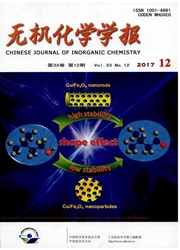

 中文摘要:
中文摘要:
讨论了辛基(苯基)-N,N-二异丁基胺甲酰基甲基氧化膦(CMPO)/1-烷基-3-甲基咪唑双(三氟甲烷磺酰)亚胺盐([Cnmim][NTf2],n=2,8,12)萃取体系分别对硝酸溶液中的铕离子(Eu^3+)和铀酰根离子(UO2^2+)的萃取行为。主要研究了硝酸浓度、接触时间、温度、CMPO浓度对CMPO/[Cnmim][NTf2]体系萃取性能的影响,并选取CMPO/[C2mim][NTf2]体系对模拟高放废液中的镧锕元素进行了萃取分离。结果表明:随着离子液体侧链长度增长,萃取平衡时间逐渐延长;CMPO/[C3+2mim][NTf2]体系对Eu的萃取是放热反应,萃取率随酸度增加而逐渐降低,对UO2^2+则是吸热反应,萃取率随酸度增加而逐渐升高;通过机理研究,推测出对Eu^3+的萃取反应是离子交换,而对UO2^2+的萃取反应则是中性配位;CMPO/[C2mim][NTf2]体系能有效的萃取模拟高放废液中的镧系、锕系元素,且在高酸下有一定的镧锕分离效果。
 英文摘要:
英文摘要:
The extraction behavior of Eu^3+and UO2^2+from nitric acid solution with n-Octyl(phenyl)-N,N diisobutylcarbamoylmethylphosphine oxide(CMPO) dissolved in hydrophobic ionic liquid [Cnmim][NTf2](n=2, 8, 12) was studied. The extraction efficiency(E) of Eu^3+and UO2^2+in CMPO/[Cnmim] [NTf2] was measured as a function of various parameters such as contact time, the concentrations of nitric acid, CMPO and temperature. CMPO/[C2mim] [NTf2] system was selected for lanthanide and actinide partitioning from simulated high level waste(SHLW). The results showed that the extraction equilibrium time extended gradually with the increasing of the chain length of the ionic liquid. The E values for Eu^3+decreased while that for UO2^2+increased with the increasing of acidity. The extraction process was endothermic for UO2 +2while the same was for Eu3 +it was exothermic. The extraction mechanism was suggested that the extraction proceed via ion exchange mechanism for Eu^3+while that for UO2^2+via neutral complex. Actinides(An) and lanthanides(Ln) could be extracted effectively from SHLW. And to some extent, An/Ln separation effectiveness was observed under high acidity using CMPO/[C2mim][NTf2] system.
 同期刊论文项目
同期刊论文项目
 同项目期刊论文
同项目期刊论文
 期刊信息
期刊信息
